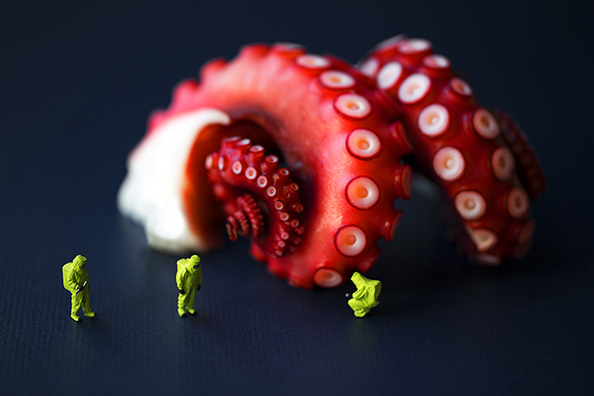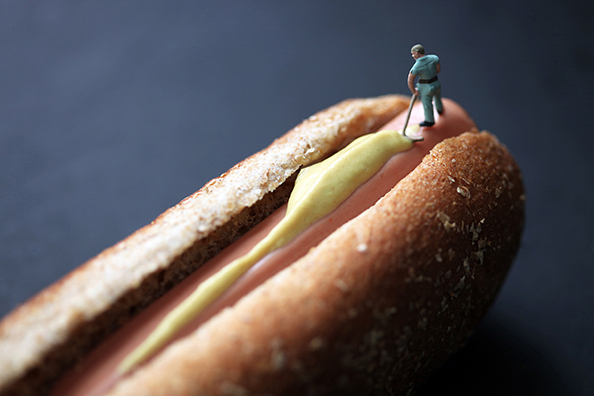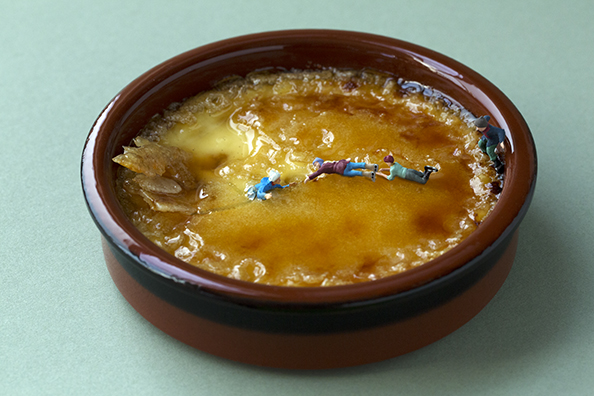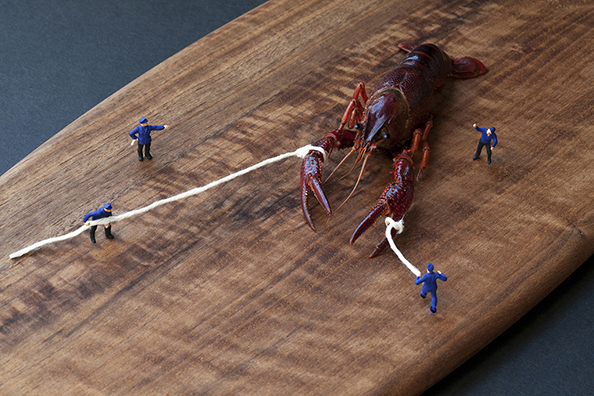Tiny figures, meticulously detailed appear as taken from a movie scene in Christopher Boffoli‘s “Big Appetites” series. The humorous scene is humorous unveils itself in surroundings made out of real food environments. Here a strawberry, there some bananas or some pasta, and little people casually fit in the surroundings having a conversation. Each image has a story line, central for understanding the idea behind the picture.
This modern version of Jonathan Swift’s Gulliver takes us in a world in which everyone can smile and resonate with the art. Combining toys, an aspect of childhood which always makes adults more emotional, and food, which brings the human aspect into the picture, Christopher’s images display a scenes as taken from a story with playful characters.
An interdisciplinary artist expanding his skills in fields like photography, writing, graphic design, and film making, Christopher has traveled the world and had his works published in 90 countries around the world. The way Christopher speaks about his art and his series is inspiring and shows the passion which he puts into making his art. In our interview with Christopher we discuss several aspects of his art and the drivers behind the “Big Appetites” series.
Components of the Big Appetites series seem calculated and in the same time natural, which give Christopher’s work an authentic vibe stirring some controversy. Nevertheless, from choosing the food items and the set-up, the creative process is a tedious one which can take up to several hours, regardless of how simple the images appear at first sight. In art as in everything, patience can be considered an important step which pushes the artist to follow his creative path.
In some respects I think a certain impatience with the world and particular aspects of it can be a catalyst for artists wanting to make art in the first place. But in reference to simply the logistics of my own work, patience is definitely required. The figures I shoot with are very tiny and I have big hands. So it can be tedious setting up some of my photographs. Things are constantly moving out of place, falling over, not working for various reasons. I think that everyone has the capacity to be creative. But most of us spend much more time consuming content than creating it. The creative process can be difficult and painful at times. So I suppose patience is one of the aspects that helps us work through the process of making things.
Behind the fascination with tiny things, which we all had as children when dimensions and scales were relative, Christopher’s works explore the idea of over-consumption of our society and bad food choices that our society faces. But as the artist came up with this series, the positive side prevailed to it.
The work is intended primarily to be surprising and funny. It is the humor that draws people in and is what they react to. But as a journalist and food writer I do also intend for the work to open up a – not negative but critical – conversation about some of America’s food dysfunction: over consumption, portion sizes, industrial production of food and the way we’ve become food spectators. One of the influences for my Big Appetites series was an ingenious work called “Travelers” by Walter Martin & Paloma Muñoz which features figures similar to mine that are presented in snow globe dioramas with an often dark in tone. I love the concept of luring in a viewer with something gorgeous and whimsical and then surprising them with something disturbing. So that is what I’m trying to do in some respects, though admittedly in a very subtle way.
A well-renowned photographer, Boffoli’s series received a lot of well deserved media attention. He speaks about getting your works out there as an artist and making a difference. Christopher was fortunate enough to get into the public’s eye quite naturally. But still, he speaks about creating the work from pure passion, and then about the rest of the aspects.
The artist Chuck Close has said that photography is the medium in which it is easiest to become technically proficient but the most difficult in distinguishing yourself with your own personal style. I think we live in a time of tremendous technological privilege in which cameras are cheap, everywhere, and give us instant results. But the problem remains in making your individual mark in an online world cluttered with so many images.
With that said, as a published photographer with images that have been seen in around 100 countries and that have gallery representation in six , I am perhaps not the best person to expound upon the difficulties with getting work seen and recognized. The reception to my work was very organic and I feel as though I was a mostly passive participant, at least in the beginning. I made these images in obscurity for the better part of a decade before they were seen by anyone outside of my close circle of friends. The important part to me is that I made them for the inherent joy of creating the work, not as part of some grand plan that they would become famous around the world. I think it is important to pursue what you love and what interests you FIRST. Earning money or gaining recognition from it is ancillary. To paraphrase Nathaniel Hawthorne, the reward should be sought in the creation of the work itself or sought in vain.
Once your work as an artist is available to the public, the difficulties arise when the Internet takes over your copyright rights and then imitators of your work appear everywhere. So getting your work out to the public has its negative sides.
The greater problem for me now is not getting the work out there, but policing the misuse of the work by people who think everything online is free to use, and especially companies and websites that seek to profit from the content I create by taking and using it without permission. Some of my unfinished work was stolen last year and continues to be spread around the Internet. The images are presented out of context, without the accompanying captions (which are just as important to the work as the photographs themselves) and many websites make it very easy for their users to violate copyrights while artists have to jump through hoops to get offending posts removed. I believe that it devalues visual art when people to take things without permission. But above all, a lot of people are wasting heaps of time aggregating the work of others and creating absolutely nothing new or original themselves. As much as the open exchange of ideas is a positive and necessary thing, I see the latter part of this as a significant problem.
Described by a tag line, each image has its own trajectory of construction. Sometimes the image comes first, other times the taglines. But as creativity involves an ever improving process, the artist is in a constant process of modifying his works until he gets to the desired effect.
Usually the image comes first. Sometimes the caption comes to me quickly while I am shooting and at other times it comes much later when I have had time to think about the context of the figures in a particular photograph. I have a very bad habit of changing the captions too which I know makes things difficult for the galleries that represent the work as they are all very thorough and careful about keeping track of the information that they share with collectors. So I try not to do it so much. But sometimes a better caption comes to mind and I just feel like the work can be improved as a result. I think this is a general condition of art. Creativity is not a fixed science but it always imperfect, changing, evolving. Nothing is ever so perfect that it can’t be changed.
The two elements of Boffoli’s photography makes his art easily accessible and understandable by anyone. Food and toys, two common things that we evoke with kindness with fresh memories of our childhood give this imagery a very nostalgic but human vibe. Bringing a feeling of good memories to his viewers, the artist leaves enough space for personal interpretation to his imagery.
The elements in this work automatically conjure memories of things that are familiar from a very early age. Regardless of language, culture or social status we all know toys and food from our youth. As children we spend a lot of time exercising our imaginations around a world of small toys that are out of scale with the world around us. And kids themselves live in an adult world that is out of scale with their own bodies. So these issues of scale and proportion surround us from the start. And I don’t think we ever lose our fascination with small things. Just consider all of the films and television shows that have used the concept of tiny people in an out of sized world. The concept of miniature representations goes back thousands of years. Consider how many museums are filled with tiny, ancient artifacts. It is a surprisingly durable cultural constant.
Likewise, food is something that is known to everyone from an early age. We all have a familiarity with food as it is essential to our survival. Whether you eat with a fork, chopsticks or your fingers everyone understands it. Sitting down to a hot meal conjures something very human inside us. And we are often comforted by foods that we first knew in childhood. So the choice of food as a component in my work was designed to evoke familiarity. I also will sometimes use iconic American junk foods which conjure emotions of their own.
So I certainly recognize how my use of what is essentially toys and food has made this work very accessible to a large number of people and is perhaps the key to why it has been so widely received. And as I said, the work is designed to open a critical conversation about our use and abuse of food in North America. However, it is also important to be to not be too forceful in my use of a “message” with the work. I never want to step out of bounds in trying to force a conversation on people or to tell them about how to approach or think about my images. Artists should always endeavor to leave room for viewers to find their own way into the work.
Although his background is quite interdisciplinary: writing, photography, graphic design, film making, Christopher has no difficulty in juggling between all of these. He considers that everybody is more or less multifaceted.
In a word, no. It is easy for me. It only looks challenging on paper perhaps because our culture relies so much on assigning labels to people. I understand that. It makes it essentially easier at a cocktail party when you ask people what they do. You can say you’re a teacher, a doctor, or an airline pilot and people instantly have an idea of what you do without you having to explain so much about yourself. But from the inside, I am just me. I am a creative person and I create in a lot of different ways, whether I am writing, shooting pictures, painting, playing music, building furniture, cooking, etc. We are all multifaceted if you think about it. Some people can be a father, a son, a sibling, a spouse, a coworker and a friend, all in the same day. It’s not difficult. The world interacts with different aspects of us all of the time. Our culture wants us to be one thing because that is easier to package. But the truth is not that clean. The world is gloriously messy and not so binary.
The “Big Appetites” series’ future is still to be explored. The artist explains his plans concerning this series.
This work has only been in the public eye for about 18 months so I’m still so busy managing the introduction of it that I haven’t had a lot of time to contemplate where the work will go next conceptually. This year I’ve been focused on a lot of shows and exhibitions. There will be more shows next year, in the US and perhaps in South America. I have a line of note cards that is available in the US, UK and Australia. I have also had editorial and corporate commissions that have kept me very busy. But most of all I have shot a lot of work – much of it completely new and unseen anywhere – for a book that will be published by Workman (NY) next year for worldwide release.
I have thought a bit about introducing more of a narrative with my figures. Perhaps knitting together stories of their adventures, which would further tie together my abilities as both a written and visual storyteller. And I have spent a bit of time contemplating possibilities for animation. Though the very small scale of my figures and the fact that they’re not articulated makes stop motion challenging. The design team who created my website (Portland, Oregon’s Fashion Buddha Studio) did a brilliant job with animating some of the images on certain pages of my website. So animation certainly is an intriguing idea.
As a world traveler, the artist thinks that this experience can be a valuable one as an artist and as a person, experience from which he hopes he has benefited.
I hope so. If you do it right, travel ought to change you. It is a privilege to have an opportunity to get outside of your comfort zone and to interact with foreign cultures and people who are different than you. The greatest value is to experience foreign places without the filters of media and governments which emphasize conflict and differences. People are really not all that different when you get down to it.
Asked what his favorite piece is, Christopher cannot decide. For him, learning what his public thinks is more important.
I get asked that question quite a lot. But that is much less interesting to me than what other people connect with and what they respond to. It is great fun to attend shows, to speak with fans and art collectors, and to learn what they like (or dislike) about my work and why.
The Big Appetites series is spread all over the world, being exhibited in different countries and different corners of the world.
Well this fall my work was part of successful exhibitions in Los Angeles, Toronto and Singapore. Right now I have pieces that are part of group shows here in Seattle (where I live and work) and in Monaco. Winston Wächter Fine Art, which represents my work at galleries in both Seattle and in New York City, have expressed interest in doing solo shows next year to coincide with the release of my book. And I am also in very early discussions with galleries in Argentina and Brazil for possible shows in South America next year. Of course between shows all of my galleries have access to my full catalog and can always field requests from collectors who wish to see and perhaps purchase work.
Asked about his future plans, the artist responded that he likes to let the stories unfold rather than to make the story himself.
There is a great line in the book Out of Africa that reads “The world was made round on purpose that you can never see too far over the horizon.” I’ve always loved the idea of letting the story unfold by itself and being poised to respond to doors of opportunity as they open. If a few years ago someone would have told me that my photographs would be globally known, that I would have gallery representation as a fine art photographer, and that I would have a book coming out with a major NY publisher I would not have believed it. So experience has proven that if I find myself exactly at the point on the map where I thought I would be then I have done something wrong. I’m mostly just grateful and fortunate for the opportunities I have now. As to what comes next one can never know.
We hope you enjoyed the story that revealed through Christopher’s images and words and that you you will let yourself emerged in this miniature but familiar world where food prevails.
Photos used with permission of Christopher Boffoli/ Exclusive interview for Mole Empire












Getting Over the Depression of a Breakup and Reclaiming Your Life | Mole Empire
[…] it’s natural to feel sad, betrayed, and let down; I even recommend gorging on a few comfort foods like a gallon of ice cream or a few chocolate bars as it’s all part of the “grieving process” […]
No comments